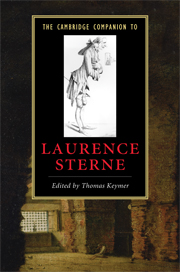Book contents
- Frontmatter
- Introduction
- 1 Laurence Sterne’s life, milieu, and literary career
- 2 Scriblerian satire, A Political Romance, the ‘Rabelaisian Fragment’, and the origins of Tristram Shandy
- 3 Tristram Shandy, learned wit, and Enlightenment knowledge
- 4 Tristram Shandy and eighteenth-century narrative
- 5 The Sermons of Mr. Yorick: the commonplace and the rhetoric of the heart
- 6 A Sentimental Journey and the failure of feeling
- 7 Sterne’s ‘politicks’, Ireland, and evil speaking
- 8 Words, sex, and gender in Sterne’s novels
- 9 Sterne and print culture
- 10 Sterne and visual culture
- 11 Sterne and the Modernist Moment
- 12 Postcolonial Sterne
- Further reading
- Index
- Series List
2 - Scriblerian satire, A Political Romance, the ‘Rabelaisian Fragment’, and the origins of Tristram Shandy
Published online by Cambridge University Press: 28 January 2010
- Frontmatter
- Introduction
- 1 Laurence Sterne’s life, milieu, and literary career
- 2 Scriblerian satire, A Political Romance, the ‘Rabelaisian Fragment’, and the origins of Tristram Shandy
- 3 Tristram Shandy, learned wit, and Enlightenment knowledge
- 4 Tristram Shandy and eighteenth-century narrative
- 5 The Sermons of Mr. Yorick: the commonplace and the rhetoric of the heart
- 6 A Sentimental Journey and the failure of feeling
- 7 Sterne’s ‘politicks’, Ireland, and evil speaking
- 8 Words, sex, and gender in Sterne’s novels
- 9 Sterne and print culture
- 10 Sterne and visual culture
- 11 Sterne and the Modernist Moment
- 12 Postcolonial Sterne
- Further reading
- Index
- Series List
Summary
The first two volumes of Tristram Shandy burst upon a surprised and marvelling world in 1759, from the pen of a clergyman almost unpublished before that date, and virtually unknown outside York ecclesiastical circles. What dragons' teeth had been sown to bear such an apparently full-grown progeny? What rough beast or shaggy dog was slouching, from Sterne's church living at Sutton-on-the-Forest, toward London to be born? We know a good deal about the literary traditions that influenced Tristram Shandy, or from which Tristram Shandy was conjured. They include (especially for Sterne's first two volumes) the writings of the French sixteenth-century humanist and humorist François Rabelais, author of Gargantua and Pantagruel; Jonathan Swift's first satiric masterpiece, A Tale of a Tub (1704), and its associated attack on enthusiastic religious dissent, A Discourse Concerning the Mechanical Operation of the Spirit; and the satires of the Scriblerus Club, particularly The Memoirs of Martinus Scriblerus, on early eighteenth-century abuses of learning. Our understanding of what such texts meant to Sterne, and how he set about re-forging these materials into something new and rather different, may be a little advanced by looking at two earlier and fragmentary pieces of writing from his hand: A Political Romance and the 'Rabelaisian Fragment'. A Political Romance was written as a contribution to a political dispute that arose in the diocese of York. Some initial disentangling of the skeins of that dispute is necessary.
- Type
- Chapter
- Information
- The Cambridge Companion to Laurence Sterne , pp. 21 - 33Publisher: Cambridge University PressPrint publication year: 2009
- 1
- Cited by



